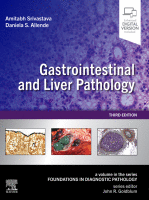Physical Address
304 North Cardinal St.
Dorchester Center, MA 02124

Nearly every histologic type of polyp involving the gastrointestinal (GI) tract can occur in a sporadic or syndromic setting. In general, a syndromic diagnosis must be suspected when multiple polyps type are present concurrently or sequentially on surveillance colonoscopy; when…

Mucosal biopsies from the colon are obtained most commonly (1) in acutely symptomatic patients with the possibility of an ischemic, infectious, or drug-induced colitis; (2) when graft-versus-host disease (GVHD) needs to be ruled out; or (3) in those with chronic…

Surgical pathologists who evaluate specimens from the gastrointestinal (GI) tract for possible infections must first attempt to differentiate histologic changes suggesting infection from other inflammatory processes. After this determination, dedicated attempts must be made to diagnose the specific infectious organisms.…

Congenital and Acquired Anatomic Anomalies of the Appendix Abnormal Location, Size, and Absence of the Appendix The appendix can have a host of anatomic abnormalities, including atypical location, duplication, and congenital absence. The position of appendix is determined by the…

Gastrointestinal Stromal Tumor Gastrointestinal stromal tumors (GISTs) are the most common soft tissue tumors of the gastrointestinal (GI) tract, with a worldwide annual incidence of about 15 cases per million. Although there was historic controversy over the distinction between GIST,…

The small intestine represents 75% of the length and 90% of the surface area of the gastrointestinal (GI) tract, yet neoplasms of the small intestine are rare, accounting for only 1% to 2% of all GI neoplasms and fewer than…

Patterns of Small Bowel Disorders The most common indication for histologic assessment of small bowel mucosa is to evaluate for a malabsorption disorder. Although the spectrum of small intestinal diseases that can result in symptoms of malabsorption can seem daunting…

Gastric carcinoma is the second most common gas-trointestinal (GI) cancer worldwide, only behind colorectal carcinoma, with more than 1 million cases diagnosed annually. With the increasing use of endoscopy, the diagnosis of early gastric cancer is more frequent, and previously…

The recognition of the central role of Helicobacter pylori in the development of what was once the most common form of chronic gastritis has elicited a significant interest in non-neoplastic gastric pathology. This has been paralleled by easier access to…

Squamous Papillomas Clinical Features These are uncommon, incidental findings at endoscopy that usually occur in women in the fifth decade of life. The vast majority are solitary; some may present as a papillomatosis. They are thought to be a reactive…